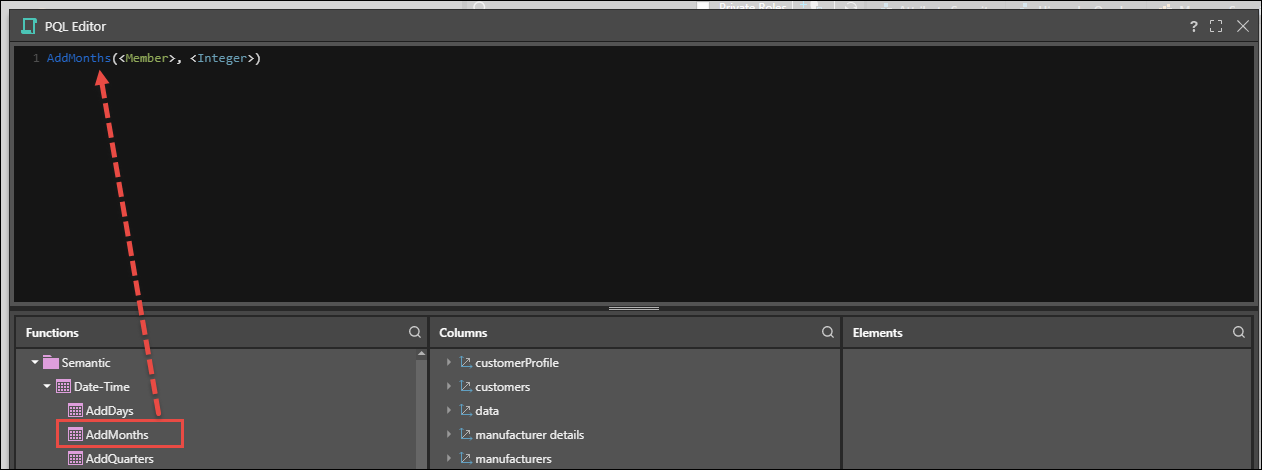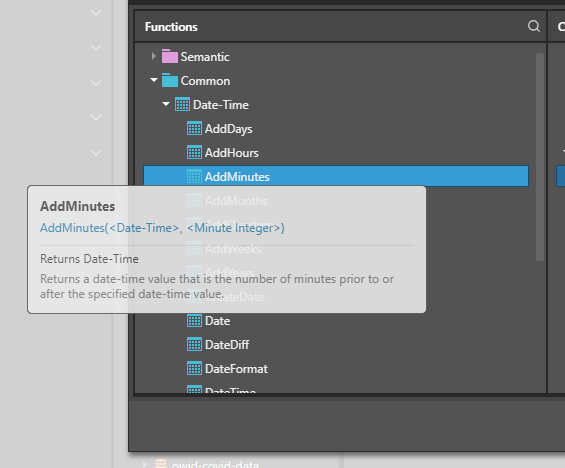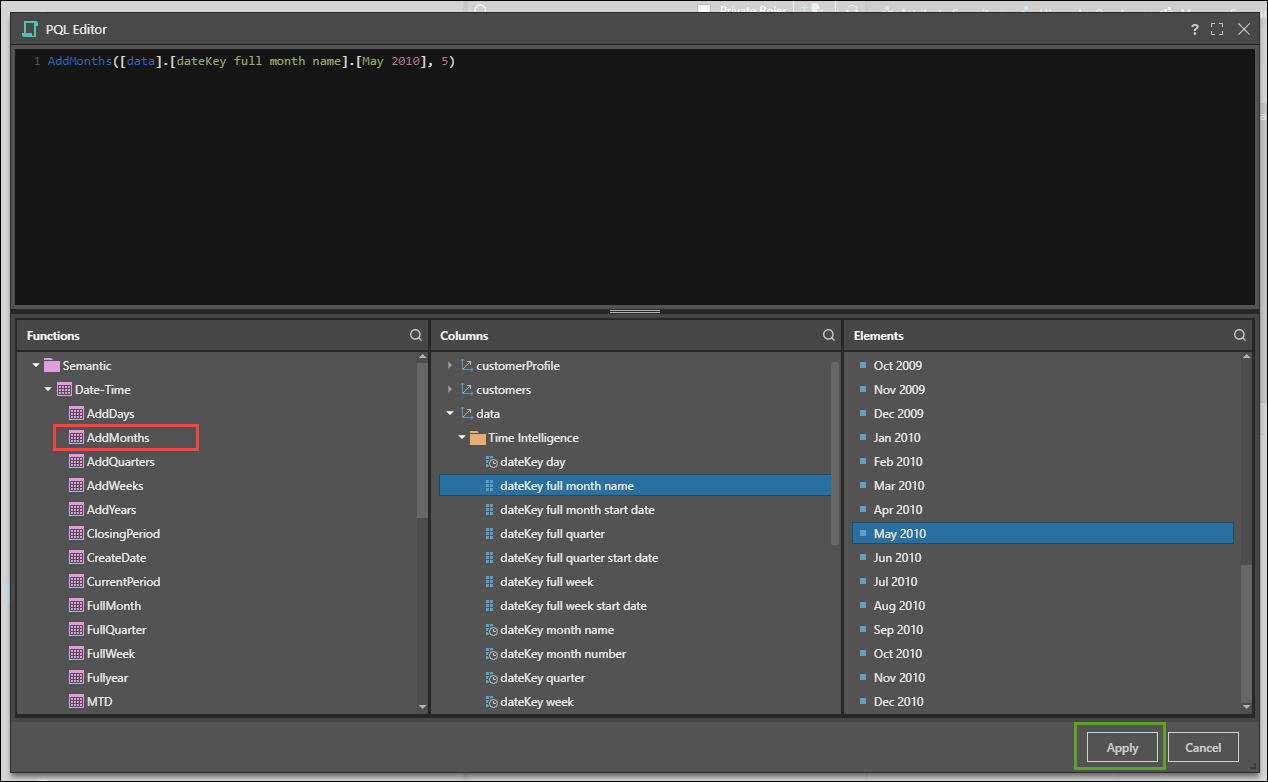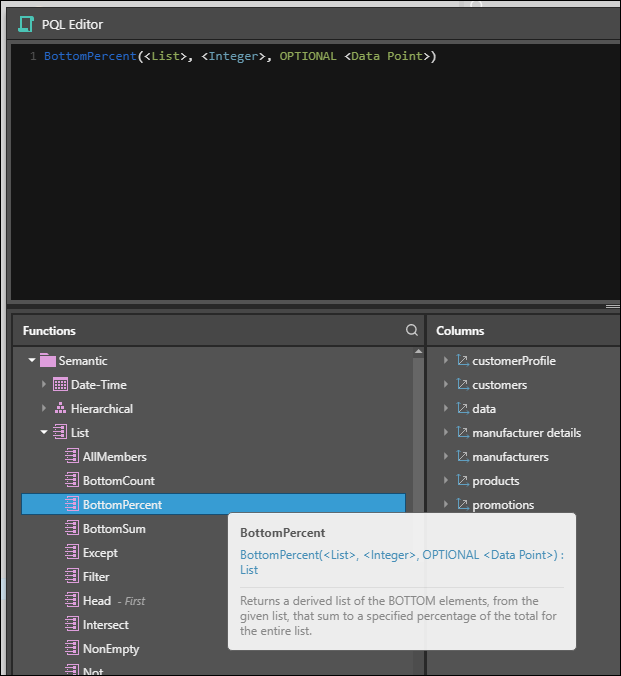The PQL Editor is used to construct PQL expressions which can then be used to drive a range of behaviors. For example, you can use the PQL Editor to build scripts to create custom columns from a data source in the Data Flow, create conditional processes in the Master Flow, define member level security on data models, and create dynamic formulations and lists than can be used in queries.
Editor Interface
The PQL Editor features a point-and-click interface, emphasizing usability. The editor exposes the model's metadata and a range of PQL functions.
Note that the PQL Integrated Development Environment (IDE) available from Formulate, and used to create custom members and lists, features a slightly different interface to the PQL Editor. This interface is also known as the Script Editor or Formulate Script Mode.
- Click here to learn about script editing in Formulate
Panels
The PQL Editor features four components, from which the expression is constructed:
- Script Window: this is where your script is written.
- Functions: exposes function libraries that can be easily navigated. The function libraries are organized into a tree structure, with a parent folder which can be expanded to expose the categories of functions within the folder. Each category can then be expanded to expose the actual functions.
- Columns: shows the meta structure of the current data model or table. Depending on the function from which the editor was opened, this may display the data model as a tree structure, with a list of the model's tables which can be expanded to expose the columns within. Alternatively, when creating a calculated column for instance, only the columns in the given table will be displayed.
- When working in Model, the columns panel also displays variables that have been constructed in the model.
- When setting Member Security in the Admin Console, the Columns panel also displays any custom columns that have been built in the model.
- Elements: exposes the elements within the selected column.
The libraries are exposed contextually, depending on the specific capability from which the editor was opened. In the image below, both the Semantic and Common libraries are displayed, but when creating calculated columns in Model, only the Common library will be shown.

Build an Expression
Expressions are built using drag and drop or double click functionality, as well as intellisense autocompletion (see below).
To select an expression, open the relevant group; either drag the expression onto the scripting window, or double click on it. In the image below, the AddMonths function was added from the Date-Time category.

Drag and Drop
Functions, columns, elements, and variables can be added to the script window by dragging and dropping them onto the window. The dropped function or item will be placed in the current cursor location in the expression.
Double-click
Alternatively, you can add functions, columns, elements, and variables to the script by double-clicking on them. Again, the added function or item will be placed in the current cursor location.
Tooltips and Help
To help you find the required functions, tooltips can be exposed for each function in the libraries, and for the library's parent folder and function categories. To see a tooltip, simply hover over the folder, function category, or function. Folder and category tooltips present a short description of the function library or category.
Function tooltips include the following:
- The function name.
- A function mask showing you what is expected as input arguments.
- The type of value the function will return.
- A brief description of the function.
Right-clicking on a folder, category, or function will show a help menu. Clicking on it will launch the given help topic in online help.

Syntax
Placeholders
In the PQL editor, any required arguments are denoted using a placeholder. For example, the AddMonths function is written:
AddMonths(<Member>, <Integer>)
The placeholders in this function are <Member> and <Integer>, which must both be replaced with the required argument to create a valid expression. For example:
AddMonths([data].[dateKey month name].[March], 6)
String Values
When inserting strings into an expression, they must be contained using "double quotes". For example, when the string function Contains() is denoted using a placeholder it appears as follows:
Contains(<List>, <Text>)
When inserting your arguments in place of the placeholder, each argument is a string and so is placed within double quotes:
Contains("Apple", "pp")

- Click here to review the 'Common' PQL functions, including syntax.
Intellisense
Intelligent Code Completion
Many users prefer to type out an expression, rather than using drag and drop or double click functionality. However, the possibility of typos, the complexity of syntax, and knowledge of the available functions can be a challenge when writing expressions. In this case, you can leverage intelligent code completion to assist in finding and writing the required functions.
The script editor features intelligent code completion functionality to help you to write expressions quickly, while avoiding typos and syntax errors. Intelligent code completion is achieved using the auto completion functionality, which is used to auto complete functions directly from the script window.
To auto complete a function, begin writing it and then hit CTRL + Space on your keyboard; this will open a pop-up list of functions that begin with the given text, arranged in alphabetical order. Select the required function from the list.
Color Coding
Pyramid employs color coding in the script editor to distinguish between different components of the expression. For example, function names are written in green, text/ string values are written in orange, numeric values are written in purple, variables are written in blue, formatting is written in orange, and incorrect syntax is displayed in red.
In the example below, the BottomPercent() function is used to build a custom set of the bottom 10% of Products by Sales. First, the BottomPercent function is added to the scripting window:

A list of all members in the Product hierarchy is inserted in the List argument; the integer specified is 10; and the Sales measure is given as the third optional argument:

Once you've finished writing your script, click Apply.